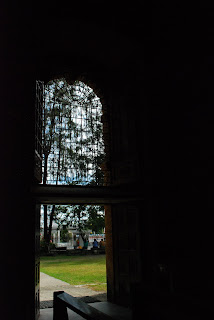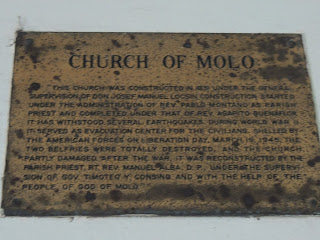Words by Lestari Hairul
Photographs by Sarah Chong and Lestari Hairul
The Philippines is home to some of the most beautiful churches in Asia and Iloilo City itself contains a high concentration of old churches. They boast amazing architecture that cross several periods and styles from Romanesque to Gothic and containing design syncretism of Spanish, Filipino, Chinese and even Muslim influences.
Guimbal Church
Guimbal Church at mid-morning.
(Photograph by Lestari Hairul)
(Photograph by Lestari Hairul)
This 400 year old church has gone through the devastation of World War II and an earthquake; its restoration has recently been completed though the church's crumbling façade has been maintained.
The belfry.
(Photograph by Sarah Chong)
(Photograph by Sarah Chong)
Built by Father Campos in 1774, the structure is made of a mix of igang (a local form of sandstone), coral stones quarried from Guimaras island and a local form of adobe stone.
Details of belfry structure, mix of yellow sandstone and local adobe.
(Photographs by Sarah Chong)
(Photographs by Sarah Chong)
Fine detail work on the pilasters (pillars), capitals and archways framing the entrances and windows are reminiscent of a Romanesque style though the detailing of flowers also hint at churrigueresque consistent with the Spanish Baroque styles evident in other Filipino churches like the one in Miagao.
Pilasters, capitals and archway details.
(Photographs by Lestari Hairul)
Further detail of bas-relief, flower motifs.
(Photographs by Sarah Chong)
Though the church has been refurbished, the façade has been left in its natural state whereever reinforcement is not needed. The rubble gathers in the corners and nature appears to be reclaiming parts of the walls.
(Photographs by Lestari Hairul)
Details of windows.
(Photographs by Sarah Chong)
Geometric designs of the floor tiles reminiscent of Andalusian/Islamic art.
Modern fixtures in a centuries old church.
(Photographs by Sarah Chong)
An altar with Byzantine artwork.
(This and succeeding photographs by Lestari Hairul)
Miagao Church: a UNESCO World Heritage site
(Photographs by Sarah Chong)
(Photographs by Lestari Hairul)
The Miagao Church was built in 1797 and is considered to be the most 'Filipino' Church because of its very localised motifs evident on the many bas-relief sculptures of the façade. Palm trees, coconut trees, guava shrubs and native costuming are prevalent all through the exterior and interior of the church.
Stone sculpture of the parish patron saint, St. Thomas of Villanueva.
(This and succeeding photographs by Lestari Hairul)
Spanish-Baroque-Romanesque influences can be seen throughout the church though the buttresses are also reminiscent of Gothic architecture.
Further detail of exterior.
(Photographs by Sarah Chong)
(Photographs by Sarah Chong)
The pure gold-plated retablo.
(Photographs by Sarah Chong)
According to local accounts, the church was built upon slave labour wherein each parishioner was forced to contribute a block of limestone and an egg each, carried on their backs from the mountainside on the threat of 25 lashes. The walls are 1.5-2 metres deep with no steel bars as frame.
A stoup containing holy water. Stoups in the shape of giant shells are common in churches through Iloilo.
(This and succeeding photographs by Lestari Hairul)
The baptismal font.
The sloping design of the windows helped in the church's role as a fortress against Muslim/Moro invaders; the ones inside could look out while the invaders could not look in.
Tigbauan Church: the Parish of St. John Sahagun
Tigbauan Church against the late afternoon sky.
(Photograph by Sarah Chong)
The Tigbauan Church offers another unique take on the churrigueresque style dating the church, at least its exterior design, to the late 17th Century although historical reports have been written of the existence of the church in a much more sedate form in the late 16th Century.
(Photographs by Sarah Chong)
What sets this church apart from the others, however, is the use of mosaic tiles in its interior decoration. Colourful, myriad tiles decorate the interior walls of the church right up to the ceiling. Even the main altar is a beautiful harmony of bright colours and fresh flowers.
(Photographs by Sarah Chong)
The Church also houses a small chapel dedicated to the Santo Niño de Cebú a representation of the infant Jesus celebrated by Filipino Catholics.
(Photographs by Lestari Hairul)
Molo Church: St. Anne Parish
(Photograph by Lestari Hairul)
This church of mainly Gothic architecture has been colloquially named the 'Feminist' Church because of the existence of 16 female saint statuaries in its interior.
The nave. On each side of the aisles, female saints are on each pillar.
(This and succeeding photographs by Sarah Chong)
Each female saint offers the petitioner the possibility of aiding in the granting of prayers specific to the saint's roles in healing or gifts.
One of the stations of the cross.
An altar dedicated to the first Filipino saint, San Lorenzo Ruiz.
A dedication to San Lorenzo Ruiz located within church grounds but outside the main church. (Photograph by Lestari Hairul)
Further examples of the Gothic-Romanesque-Renaissance architecture.
(Photographs by Sarah Chong)
There is also a plaza in front of the church, as in the Spanish style, along with a bandstand that contains statuary of the main female goddesses of Ancient Greece. Perhaps this was meant as a juxtaposition of female representations of the Pagan world and the Christian world.
The Roman Catholic Church and the Greek Pagan bandstand in a Spanish colonial plaza of Molo, Iloilo City, a Filipino locale.
(Photograph by Lestari Hairul)
There are many more magnificent churches that we could not cover in our short time in Iloilo. It is with hope that in the future we will be able to visit, photograph and learn more about the architecture and history of these beautiful representations of piety.
Blogger Profile
Lestari just completed her first year and is determined to make her second year even more exciting and interesting. Lestari also likes reading, writing and 'rithmetic.
Lestari just completed her first year and is determined to make her second year even more exciting and interesting. Lestari also likes reading, writing and 'rithmetic.





















































































No comments:
Post a Comment